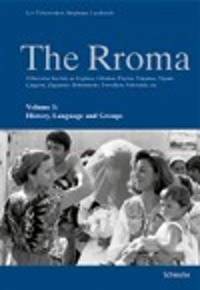THE RROMA
Lev Tcherenkov & Stéphane Laederich
Schwabe Verlag, ISBN 3-7965-2090-1
2 Bände / 2 Volumes, ca. 1,100 Pages
Rroma are usually presented in a fragmentary and parcelled fashion: one hears about Rroma, Sinti, and Cale and hundreds of other groups. Language, traditions, and origins are often presented as being fundamentally different. One thus gains the impression that Gypsies are not a single minority but a mosaic of different ones. This book presents a unified view of the various Rroma groups, their history and culture and underlines their commonality rather than differences and small local variations and its aim is to present this European minority to the general public and specialists alike.
Rromanes – the Rroma language – is extensively used to provide a clear picture of the Rroma history from the Indian origins to current times. Whenever a lack of documents forces one in the realm of conjectures, Rromanes provides a clear thread, for its layered structure is a perfect analysis tool.

L'histoire
The first part of the book is devoted to the history of the Rroma, from their migration to India, Persia, Armenia, their arrival in the Byzantine Empire, and finally, to their spread throughout Europe, up to modern history and the fall of the communism. This book aims to “redress” the tilt found in most books, namely the tilt towards Western Europe where, from the fourteenth century onward, most of the historical material can be found. After all, these Rroma represent but a small fraction of the entire Rroma population. It presents arguments, linguistic, among others, showing that all Rroma stem from one single and homogenous migration wave which arrived in Europe in the latter years of the first millennium and that the Rroma as such are a truly European minority – albeit of Indian origins. The history of the Rroma migrations, when checked against the known material and especially the language, becomes rather simple and, although it dispels some myths or commonly accepted “truth”, fits closely the facts.
Rromanes, Metagroups and Groups
The second part of this book starts on Rromanes, as the Rroma language is at the basis of the entire analysis of this minority. It presents a brief outline of Rromanes, its grammar and morphology as well as its syntax and aims to show the similitude between variants. After all, the bulk of the lexems, the morphology is common to all Rroma groups. The differences in dialects arising from further migrations within Europe. The next chapters are devoted to groups and their internal structures: what is a group, its structures, its organisation, with some very specific examples, such as a nearly complete description of groups, subgroups, lineages and families found on the territory of the former Soviet Union. Finally, the four metagroups and their specifics, both linguistic and cultural are presented in details. This is by far the more technical part of the book, but is nevertheless not reserved to specialists.
Work and Traditions
The third part of the book is devoted to traditions and culture. It includes trades, housing, traditions, such as ritual cleanness, the kris (tribunal), and family as well as the culture proper. This part of the book is almost entirely based almost on the author’s experience with Rroma from various groups and regions of Europe as well as on extensive research. In the case of traditional tribunals, the book provides for example concrete examples of real judgements.
Texts
Finally, the last part presents texts in all of the dialects and from all the groups referred to in the book, together with a rather literal English translation. There are thus over fifty texts in the original dialects which both give a glimpse in the rich Rroma folklore as well as in the various Rromanes variants
Publisher: